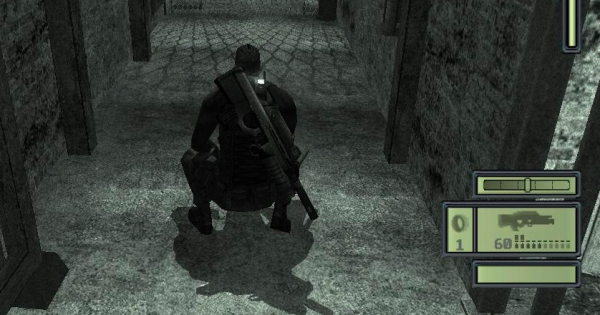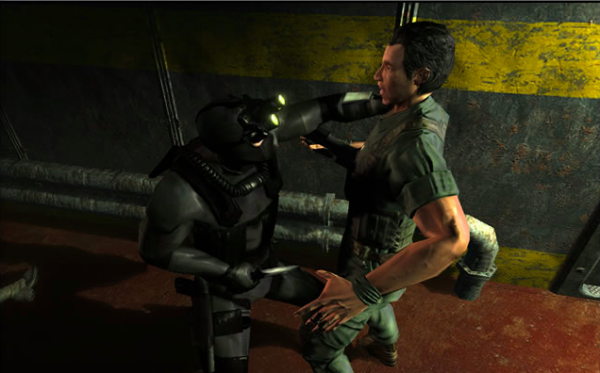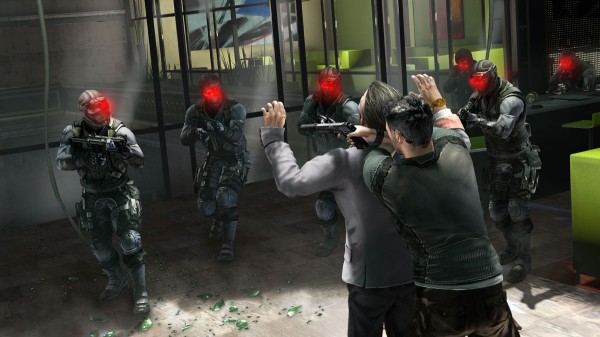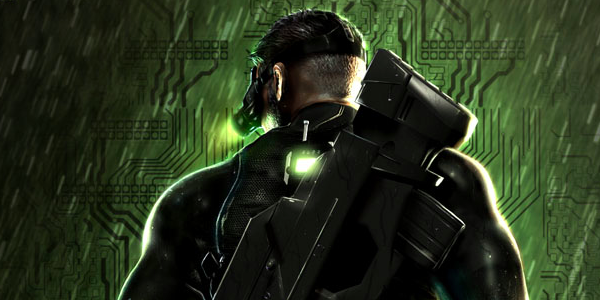When you hear the iconic buzz and see three green lights come into view, you know immediately what it was. Splinter Cell had become a cultural icon, and the trifocal lenses were just one of the standout elements. Sam Fisher was an icon, along with Ironside’s ducal tones, as we followed Fisher through scenarios around the globe representing the Third Echelon, a black ops sub-division of the NSA.
Splinter Cell, having first came into the scene in 2002, had more or less changed the stealth genre, for better or worse. For everyone of those who weren’t in the mood for Thief’s atmospheric and fantasy setting, or Metal Gear’s Solid touted ‘tactical espionage action’ and heavy handed exposition, Splinter Cell looked to tackle the stealth genre in the form of black ops, modern day stealth, with a focus on government conspiracy and covert operations. Splinter Cell for the most part, was highly praised for it’s unique take on the stealth genre, and remains one of Ubisoft’s biggest franchises.
Looking back to Splinter Cell now, the original hasn’t aged well. The first game was mostly linear, not only in level design but in it’s structure (3 alarms and you’re out). The strict nature of the game led to a sort of trial and error mode, memorizing enemy patterns and figuring out the perfect way through a level, making sure to perfectly hide bodies as the automatic sweep the game did after every area would be very picky in what constitutes a hidden body as opposed to one out in the open. The quicksave/quickload buttons were the two most used keys in the game. But for it’s time, it was marked a revolution. And for good reason. The graphics were spectacular, specifically due to it’s lighting system. Splinter Cell played with light and dark, and despite the fact that you played a 6 foot beast with glowing green lenses, the immersion of staying perfectly still as a guard crept closer and closer was thrilling. In well lit areas, you could shoot out lights to create shadows.

Pandora Tomorrow, despite rigidly sticking to the original’s formula, remains my stout favorite. The levels were superbly designed and despite the 3 alarm formula and linear design, it was simply more fun. I still remember panicking as I chose to execute a seemingly innocent woman in Jerusalem, or holding the main antagonist hostage as I dragged him away from a radio station and into a plane. I obsessed over moves like the split jump and the SWAT turn. Pandora Tomorrow also introduced the widely acclaimed favorite Spies vs Mercs multiplayer mode, but due to it’s relatively early life on the Xbox, wasn’t as popular as it could have been. All I can say is that if you plan on revisiting this gem, do so on the PC. The trial and error gameplay suits the quicksave options for PC, whilst console versions rely on a sometimes infuriating checkpoint system.
Chaos Theory remains the pinnacle of the series. Released in 2005, it not only revolutionized Splinter Cell, it revolutionized the stealth genre entirely since it’s inception. Even 8 years later the game looks downright gorgeous, with huge improvements made to environments, animations and most importantly, a now dynamic lighting system. Chaos Theory looked great, played great, and opened up levels for a much more flexible stealth game. No longer shoehorned into one area, Chaos Theory allowed for multiple paths through places, where you could opt to avoid enemies entirely, with multiple objectives to tackle if one were inclined to do so. With a scoring system in place, the motivation to stay non-lethal and silent was enticing, without the need for strict guidelines. The OCP pistol allowed for disabling of lights and electronics, opening up a more strategic style of gameplay, along with optional loadouts at the start of the mission that allowed you to choose between complete stealth, non-lethal routes and lethal routes, the removal of the strict ‘3 alarms and you’re out’ style, and flexible rules made Chaos Theory the pinnacle of stealth gaming. Spies vs Mercs was perfected in Chaos Theory. Masterful map designs, fun and varied gameplay, and balanced modes allowed for a perfect balance of skill and fun. Simply put, there’s a reason why people turn to Chaos Theory as the prime example when talking about Splinter Cell.

Double Agent marked the first foray into 360/PS3 territory, and was widely disregarded unfortunately. Many people derided the slow pace of the ‘headquarters’ missions, where you had to complete objectives in a 30 minute window, and the new ‘trust’ system, that forced you to balance between the NSA and the terrorist organization you infiltrated, JBA. I personally loved the trust system. It engaged in a philosophical and interesting manner. Which objectives should you fulfill? Can you afford losing any more trust with one organization? Trying to fulfill all objectives was both challenging and satisfying, and balancing between the two organizations led to several moral dilemmas that were both intriguing and led to difficult resolutions. Double Agent had Fisher at his most conflicted, and was Splinter Cell’s finest story yet (which still isn’t saying much, since story was never a strong suit). Double Agent remains Splinter Cell’s black dog, shunned by critic and audience alike. Which is a shame, because Double Agent is a strong entry. Following Chaos Theory was always going to be tough, and while this doesn’t live up to it’s previous installment, it remains a very solid entry.
Splinter Cell Conviction is where fans started to lose faith. After the commercial failure of Double Agent, Ubisoft decided to streamline Splinter Cell into a gritty third person action shooter. First branded as an ‘crowd stealth’ game in an almost disastrous E3 demo, Ubisoft were forced to streamline the final product and release an entirely different game, one that was rushed to release. Stealth was still the main focus, but it was a different kind of stealth. Combat was mandatory now. You HAD to kill your targets, and the main mechanic revolved around the ‘mark and execute’ feature, which was basically a cheat code to automatically kill 3-4 enemies. You clicked a button to ‘mark’ the enemy, and once you had done a hand-to-hand takedown, you could eliminate those marks at another press of a button. Minimal aiming, minimal effort. Non-lethal was no longer an option, it was kill or be killed. Conviction lost fans everywhere for it’s loss of focus on stealth. Pushing Sam Fisher into a rogue position (no longer part of Third Echelon) and attempting to tell a story that paints Fisher as sympathetic and vulnerable, instead just came off as empty and unfulfilling.

However, Conviction wasn’t a bad game by all means. While a terrible Splinter Cell game, it was a very solid third person shooter. The animations were top notch, sliding from cover to cover looked and felt amazing, the takedowns were smooth, nailing a perfect run without any alerts was still satisfying, and the co-op mode was fully fledged out and addictive. However, it lost it’s charm; Fisher was no longer the wisecracking sarcastic spy agent, Ironside wasted playing Fisher as the gritty rogue agent, the flexibility with non-lethal was completely gone and it’s complete shelving of slow paced methodical stealth in lieu of ‘aggressive’ stealth combat led to many fans deriding it as an unworthy piece of Splinter Cell canon.
Like I said, Conviction remains a solid third person shooter, but as a Splinter Cell game it fails on many points.
Luckily, Splinter Cell Blacklist has just come out. Has Ubisoft fixed the mistakes of Conviction? Stay tuned for my Blacklist review.



